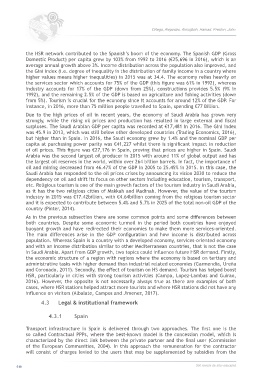Page 520 - 360.revista de Alta Velocidad - Nº 6
P. 520
Ortega, Alejandro. Almujibah, Hamad. Preston, John.
the HSR network contributed to the Spanish’s boom of the economy. The Spanish GDP (Gross
Domestic Product) per capita grew by 103% from 1992 to 2016 (€25,696 in 2016), which is an
average annual growth above 3%. Income distribution across the population also improved, and
the Gini index (i.e. degree of inequality in the distribution of family income in a country where
higher values means higher inequalities) in 2015 was at 34.4. The economy relies heavily on
the services sector which accounts for 75% of the GDP (this figure was 61% in 1992), whereas
industry accounts for 17% of the GDP (down from 25%), constructions provides 5.5% (9% in
1992), and the remaining 2.5% of the GDP is based on agriculture and fishing activities (down
from 5%). Tourism is crucial for the economy since it accounts for around 12% of the GDP. For
instance, in 2016, more than 75 million people travelled to Spain, spending €77 Billion.
Due to the high prices of oil in recent years, the economy of Saudi Arabia has grown very
strongly, while the rising oil prices and production has resulted in large external and fiscal
surpluses. The Saudi Arabian GDP per capita was recorded at €17,481 in 2016. The Gini index
was 45.9 in 2013, which was still below other developed countries (Trading Economics, 2016),
but higher than in Spain. In 2016, the Saudi economy grew by 1.4% and the nominal GDP per
capita at purchasing power parity was €41,227 whilst there is significant impact in reduction
of oil prices. This figure was €27,176 in Spain, proving that prices are higher in Spain. Saudi
Arabia was the second largest oil producer in 2015 with around 11% of global output and has
the largest oil reserves in the world, within over 264 billion barrels. In fact, the importance of
oil and mining decreased from 46.47% of the GDP in 2005 to 25.45% in 2015. In this case, the
Saudi Arabia has responded to the oil prices crises by announcing its vision 2030 to reduce the
dependency on oil and shift its focus on other sectors including education, tourism, transport,
etc. Religious tourism is one of the main growth factors of the tourism industry in Saudi Arabia,
as it has the two religious cities of Makkah and Madinah. However, the value of the tourism
industry in 2015 was €17.42billion, with €4.64billion coming from the religious tourism sector
and it is expected to contribute between 5.4% and 5.7% in 2025 of the total non-oil GDP of the
country (Pinter, 2014).
As in the previous subsection there are some common points and some differences between
both countries. Despite some economic turmoil in the period both countries have enjoyed
buoyant growth and have redirected their economies to make them more services-oriented.
The main differences arise in the GDP configuration and how income is distributed across
population. Whereas Spain is a country with a developed economy, services-oriented economy
and with an income distribution similar to other Mediterranean countries, that is not the case
in Saudi Arabia. Apart from GDP growth, two topics could influence future HSR demand. Firstly,
the economic structure of a region with regions where the economy is based on tertiary and
administrative tasks with higher demand than industrial related economies (Garmendia, Ureña
and Coronado, 2011). Secondly, the effect of tourism on HS demand. Tourism has helped boost
HSR, particularly in cities with strong tourism activities (Campa, Lopez-Lambas and Guirao,
2016). However, the opposite is not necessarily always true as there are examples of both
cases, where HSR stations helped attract more tourists and where HSR stations did not have any
influence on visitors (Albalate, Campos and Jimenez, 2017).
4.3 Legal & institutional framework
4.3.1 Spain
Transport infrastructure in Spain is delivered through two approaches. The first one is the
so called Contractual PPPs, where the best-known model is the concession model, which is
characterized by the direct link between the private partner and the final user (Commission
of the European Communities, 2004). In this approach the remuneration for the contractor
will consist of charges levied to the users that may be supplemented by subsidies from the
518 360.revista de alta velocidad

